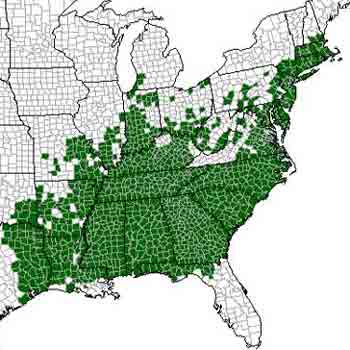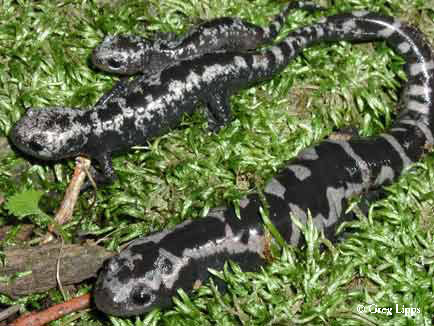
Marbled Salamander
(Ambystoma opacum)
 |
 |
|
|
Distribution of the Marbled Salamander (from the AR MI Atlas)
|
Three Marbled Salamanders.
|
|
Description: A short (3.5-5.5”) stout salamander, easily recognizable by its black ground color with white or silver crossbands across the body and tail. The bands can be quite variable in their size and shape, and individuals lacking any markings have been reported. The underside is all black. |
||
Distribution in Ohio: Throughout the state. |
||
|
|
||
Status in Ohio: Generally uncommon. Populations are disjunct and widely scattered and most common in the southeastern portion of the state. |
||
|
|
||
Habitat: Mature deciduous forest with vernal or floodplain pools for breeding. |
||
|
|
||
Life history: Unlike the other members of this genus found in Ohio, the breeding season for the Marbled Salamander is in the autumn and courtship, breeding, and egg-laying all occur on land. The eggs are laid in September or October under logs, moss, leaves, or debris along the margins of a vernal pool and are attended to by the female. When autumn rains fill the pool and inundate the eggs, the female leaves and the eggs hatch. The aquatic larvae then overwinter in the pond, completing metamorphosis the following spring or summer. Adults live in adjacent forests, in burrows and under rotting logs and leaf litter. |
||
|
|
||
Conservation: Marbled Salamander populations only occur in mature deciduous forests having wetland areas for breeding. Destruction of these habitats, including wetland draining and filling, urbanization, and logging, are the greatest threats to these populations. Pollution, including pesticides and herbicides, are easily absorbed into the porous skin of salamanders and are toxic. Predatory fish introduced into a breeding pond will exterminate a population. |
||
Last modified:
|
Ohio Amphibians · Ohio Salamander Web · Ohio Salamander Species · Amphibian Habitats · Salamander Monitoring |
|